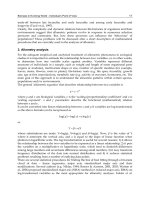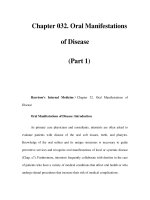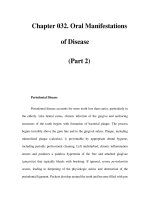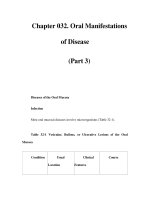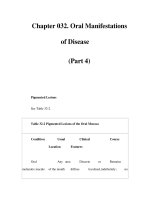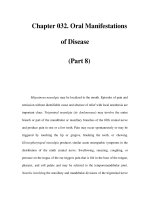Chapter 032. Oral Manifestations of Disease (Part 2) potx
Bạn đang xem bản rút gọn của tài liệu. Xem và tải ngay bản đầy đủ của tài liệu tại đây (15.79 KB, 5 trang )
Chapter 032. Oral Manifestations
of Disease
(Part 2)
Periodontal Disease
Periodontal disease accounts for more tooth loss than caries, particularly in
the elderly. Like dental caries, chronic infection of the gingiva and anchoring
structures of the tooth begins with formation of bacterial plaque. The process
begins invisibly above the gum line and in the gingival sulcus. Plaque, including
mineralized plaque (calculus), is preventable by appropriate dental hygiene,
including periodic professional cleaning. Left undisturbed, chronic inflammation
ensues and produces a painless hyperemia of the free and attached gingivae
(gingivitis) that typically bleeds with brushing. If ignored, severe periodontitis
occurs, leading to deepening of the physiologic sulcus and destruction of the
periodontal ligament. Pockets develop around the teeth and become filled with pus
and debris. As the periodontium is destroyed, teeth loosen and exfoliate.
Eventually there is resorption of the alveolar bone. A role for the chronic
inflammation resulting from chronic periodontal disease in promoting coronary
heart disease and stroke has been proposed. Epidemiologic studies demonstrate a
moderate but significant association between chronic periodontal inflammation
and atherogenesis, though a causal role remains unproven.
Acute and aggressive forms of periodontal disease are less common than
the chronic forms described above. However, if the host is stressed or exposed to a
new pathogen, rapidly progressive and destructive disease of the periodontal tissue
can occur. A virulent example is acute necrotizing ulcerative gingivitis (ANUG),
or Vincent's infection, characterized as "trench mouth" during World War I. Stress,
poor oral hygiene, and tobacco and alcohol use are risk factors. The presentation
includes sudden gingival inflammation, ulceration, bleeding, interdental gingival
necrosis, and fetid halitosis. Localized juvenile periodontitis, seen in adolescents,
is particularly destructive and appears to be associated with impaired neutrophil
chemotaxis. AIDS-related periodontitis resembles ANUG in some patients or a
more destructive form of adult chronic periodontitis in others. It may also produce
a gangrene-like destructive process of the oral soft tissues and bone that resembles
noma, seen in severely malnourished children in developing nations.
Prevention of Tooth Decay and Periodontal Infection
Despite the reduced prevalence of dental caries and periodontal disease in
the United States due in large part to water fluoridation and improved dental care,
respectively, both diseases constitute a major public health problem worldwide
and for certain groups. The internist should promote preventive dental care and
hygiene as part of health maintenance. Special populations at high risk for dental
caries and periodontal disease include those with xerostomia, diabetics, alcoholics,
tobacco users, those with Down's syndrome, and those with gingival hyperplasia.
Furthermore, patients lacking dental care access (low socioeconomic status) and
those with reduced ability to provide self-care (e.g., nursing home residents, those
with dementia or upper extremity disability) suffer at a disproportionate rate. It is
important to provide counseling regarding regular dental hygiene and professional
cleaning, use of fluoride-containing toothpaste, professional fluoride treatments,
and use of electric toothbrushes for patients with limited dexterity and to give
instruction to caregivers for those unable to perform self-care. Internists caring for
international students studying in the United States should be aware of the high
prevalence of dental decay in this population. Cost, fear of dental care, and
language and cultural differences may create barriers that prevent some from
seeking preventive dental services.
Developmental and Systemic Disease Affecting the Teeth and
Periodontium
Malocclusion is the most common developmental problem, which, in
addition to a problem with cosmesis, can interfere with mastication unless
corrected through orthodontic techniques. Impacted third molars are common and
occasionally become infected. Acquired prognathism due to acromegaly may also
lead to malocclusion, as may deformity of the maxilla and mandible due to Paget's
disease of the bone. Delayed tooth eruption, receding chin, and a protruding
tongue are occasional features of cretinism and hypopituitarism. Congenital
syphilis produces tapering, notched (Hutchinson's) incisors and finely nodular
(mulberry) molar crowns.
Enamel hypoplasia results in crown defects ranging from pits to deep
fissures of primary or permanent teeth. Intrauterine infection (syphilis, rubella),
vitamin deficiency (A, C, or D), disorders of calcium metabolism (malabsorption,
vitamin D–resistant rickets, hypoparathyroidism), prematurity, high fever, or rare
inherited defects (amelogenesis imperfecta) are all causes. Tetracycline, given in
sufficiently high doses during the first 8 years, may produce enamel hypoplasia
and discoloration. Exposure to endogenous pigments can discolor developing
teeth: erythroblastosis fetalis (green or bluish-black), congenital liver disease
(green or yellow-brown), and porphyria (red or brown that fluoresces with
ultraviolet light). Mottled enamel occurs if excessive fluoride is ingested during
development. Worn enamel is seen with age, bruxism, or excessive acid exposure
(e.g., chronic gastric reflux or bulimia).
Premature tooth loss resulting from periodontitis is seen with cyclic
neutropenia, Papillon-Lefèvre syndrome, Chédiak-Higashi syndrome, and
leukemia. Rapid focal tooth loosening is most often due to infection, but rarer
causes include histiocytosis X, Ewing's sarcoma, osteosarcoma, or Burkitt's
lymphoma. Early loss of primary teeth is a feature of hypophosphatasia, a rare
inborn error of metabolism.
Pregnancy may produce severe gingivitis and localized pyogenic
granulomas. Severe periodontal disease occurs with Down's syndrome and
diabetes mellitus. Gingival hyperplasia may be caused by phenytoin, calcium
channel blockers (e.g., nifedipine), and cyclosporine. Idiopathic familial gingival
fibromatosis and several syndrome-related disorders appear similar. Removal of
the medication often reverses the drug-induced form, though surgery may be
needed to control both. Linear gingival erythema is variably seen in patients with
advanced HIV infection and probably represents immune deficiency and
decreased neutrophil activity. Diffuse or focal gingival swelling may be a feature
of early or late acute myelomonocytic leukemia (AML) as well as of other
lymphoproliferative disorders. A rare, but pathognomonic, sign of Wegener's
granulomatosis is a red-purplish, granular gingivitis (strawberry gums).
